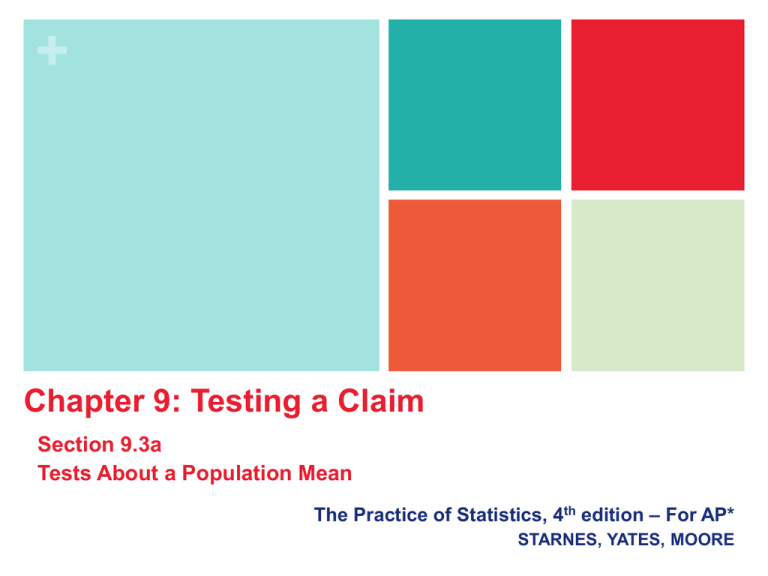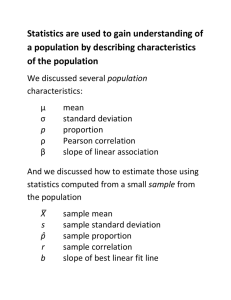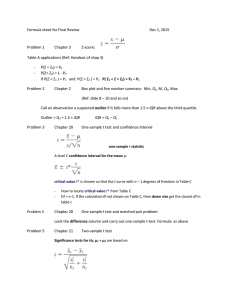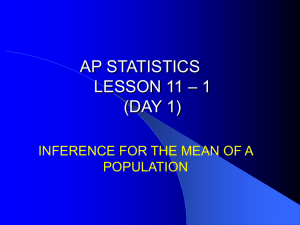9.3a Tests for Pop Mean t
advertisement

+ Chapter 9: Testing a Claim Section 9.3a Tests About a Population Mean The Practice of Statistics, 4th edition – For AP* STARNES, YATES, MOORE + Section 9.3a Tests About a Population Mean Target Goals: I can CHECK conditions for carrying out a test about a population mean. I can CONDUCT a one-sample t test about a population mean. I can CONSTRUCT a confidence interval to draw a conclusion for a two-sided test about a population mean. Hw: pg 564: 57 – 60; pg 588:71, 73 Inference about a population mean µ uses a t distribution with n - 1 degrees of freedom, except in the rare case when the population standard deviation σ is known. We learned how to construct confidence intervals for a population mean in Section 8.3. Now we’ll examine the details of testing a claim about an unknown parameter µ. Tests About a Population Mean Confidence intervals and significance tests for a population proportion p are based on z-values from the standard Normal distribution. + Introduction Out a Significance Test for µ To find out, we must perform a significance test of H0: µ = 30 hours Ha: µ > 30 hours where µ = the true mean lifetime of the new deluxe AAA batteries. Check Conditions: Three conditions should be met before we perform inference for an unknown population mean: Random, Normal, and Independent. The Normal condition for means is Population distribution is Normal or sample size is large (n ≥ 30) We often don’t know whether the population distribution is Normal. But if the sample size is large (n ≥ 30), we can safely carry out a significance test (due to the central limit theorem). If the sample size is small, we should examine the sample data for any obvious departures from Normality, such as skewness and outliers. Tests About a Population Mean Ex: A company claims to have developed a new AAA battery that lasts longer than its regular AAA batteries. Based on years of experience, the company knows that its regular AAA batteries last for 30 hours of continuous use, on average. An SRS of 15 new batteries lasted an average of 33.9 hours with a standard deviation of 9.8 hours. Do these data give convincing evidence that the new batteries last longer on average? + Carrying Three conditions should be met before we perform inference for an unknown population mean: Random, Normal, and Independent. Random The company tests an SRS of 15 new AAA batteries. Normal We don’t know if the population distribution of battery lifetimes for the company’s new AAA batteries is Normal. With such a small sample size (n = 15), we need to inspect the data for any departures from Normality. + a Significance Test for µ Tests About a Population Mean Carrying Out Check Conditions: The dotplot and boxplot show slight right-skewness but no outliers. The Normal probability plot is close to linear. We should be safe performing a test about the population mean lifetime µ. Independent Since the batteries are being sampled without replacement, we need to check the 10% condition: there must be at least 10(15) = 150 new AAA batteries. This seems reasonable to believe. Out a Significance Test For a test of H0: µ = µ0, our statistic is the sample mean. Its standard deviation is x n Because the population standard deviation σ is usually unknown, we use the sample standard deviation sx in its place. The resulting test statistic has the standard error of the sample mean in the denominator x 0 t sx n When the Normal condition is met, this statistic has a t distribution with n - 1 degrees of freedom. Test About a Population Mean Calculations: Test statistic and P-value When performing a significance test, we do calculations assuming that the null hypothesis H0 is true. The test statistic measures how far the sample result diverges from the parameter value specified by H0, in standardized units. As before, statistic - parameter test statistic = standard deviation of statistic + Carrying Out a Hypothesis Test x 33.9 hours and sx 9.8 hours. statistic - parameter test statistic = standard devia deviation tion of statistic t x 0 33.9 30 1.54 sx 9.8 15 n The P-value is the probability of getting a result this large or larger in the direction indicated by Ha, that is, P(t ≥ 1.54). Upper-tail probability p df .10 .05 .025 13 1.350 1.771 2.160 14 1.345 1.761 2.145 15 1.341 1.753 3.131 80% 90% 95% Confidence level C Go to the df = 14 row. Tests About a Population Mean The battery company wants to test H0: µ = 30 versus Ha: µ > 30 based on an SRS of 15 new AAA batteries with mean lifetime and standard deviation + Carrying Since the t statistic falls between the values 1.345 and 1.761, the “Upper-tail probability p” is between 0.10 and 0.05. The P-value for this test is between 0.05 and 0.10. Try Dist:tcdf(1.54,E99, 14) p=.0729 Because the P-value (.0729) exceeds our default α = 0.05 sig. level, we fail to reject H0 and can’t conclude that the company’s new AAA batteries last longer than 30 hours, on average. One-Sample t Test One-Sample t Test Choose an SRS of size n from a large population that contains an unknown mean µ. To test the hypothesis H0 : µ = µ0, compute the one-sample t statistic x 0 t Use this testsxonly when n (1) the population distribution is Normal or the sample is large Find the P-value by calculating the probability of getting a t statistic this large (ndirection ≥ 30), and (2) the population at or larger in the specified by the alternativeishypothesis Ha in a tdistribution with dfleast = n - 10 1 times as large as the sample. Tests About a Population Mean When the conditions are met, we can test a claim about a population mean µ using a one-sample t test. + The Healthy Streams + Example: The level of dissolved oxygen (DO) in a stream or river is an important indicator of the water’s ability to support aquatic life. A researcher measures the DO level at 15 randomly chosen locations along a stream. Here are the results in milligrams per liter: 4.53 5.42 5.04 6.38 3.29 4.01 5.23 4.66 4.13 2.87 5.50 5.73 4.83 5.55 State: We want to perform a test at the α = 0.05 significance level of H0: µ = 5 Ha: µ < 5 where µ is the actual mean dissolved oxygen level in this stream. Tests About a Population Mean A dissolved oxygen level below 5 mg/l puts aquatic life at risk. 4.40 Healthy Streams Normal We don’t know whether the population distribution of DO levels at all points along the stream is Normal. With such a small sample size (n = 15), we need to look at the data to see if it’s safe to use t procedures. Plot data using either a histogram, boxplot or normal probability plot. The histogram looks roughly symmetric; the boxplot shows no outliers; and the Normal probability plot is fairly linear. With no outliers or strong skewness, the t procedures should be pretty accurate even if the population distribution isn’t Normal. Independent There is an infinite number of possible locations along the stream, so it isn’t necessary to check the 10% condition. We do need to assume that individual measurements are independent. Tests About a Population Mean Plan: If conditions are met, we should do a one-sample t test for µ. Random The researcher measured the DO level at 15 randomly chosen locations. We must assume SRS. + Example: Healthy Streams Test statistic t x 0 4.771 5 0.94 0.9396 sx 15 n P-value The P-value is the area to the left of t = -0.94 under the t distribution curve with df = 15 – 1 = 14. Dist:tcdf(-E99,-0.94,14) Conclude: The P-value, .1816 is greater than our α = 0.05 significance level, we fail to reject H0. We don’t have enough evidence to conclude that the mean DO level in the stream is less than 5 mg/l. Since we decided not to reject H0, we could have made a Type II error (failing to reject H0when H0 is false). If we did, then the mean dissolved oxygen level µ in the stream is actually less than 5 mg/l, but we didn’t detect that with our significance test. p=.1816 Tests About a Population Mean Do: The sample mean and standard deviation are x 4.771 and sx 0.9396 + Example:







